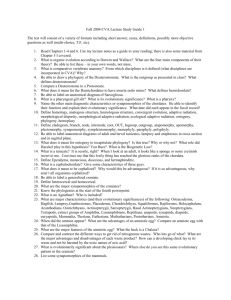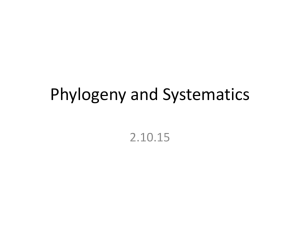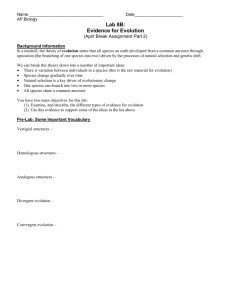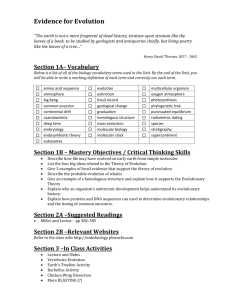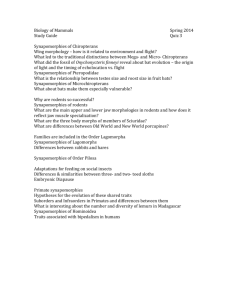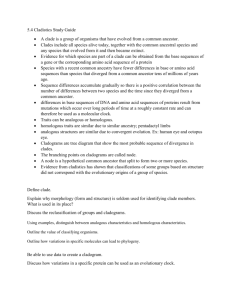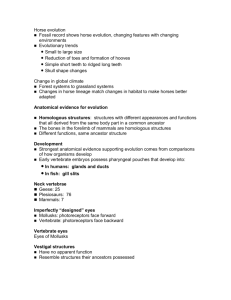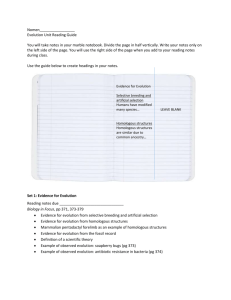BIOLOGICAL CLASSIFICATION & EVOLUTION bold
advertisement
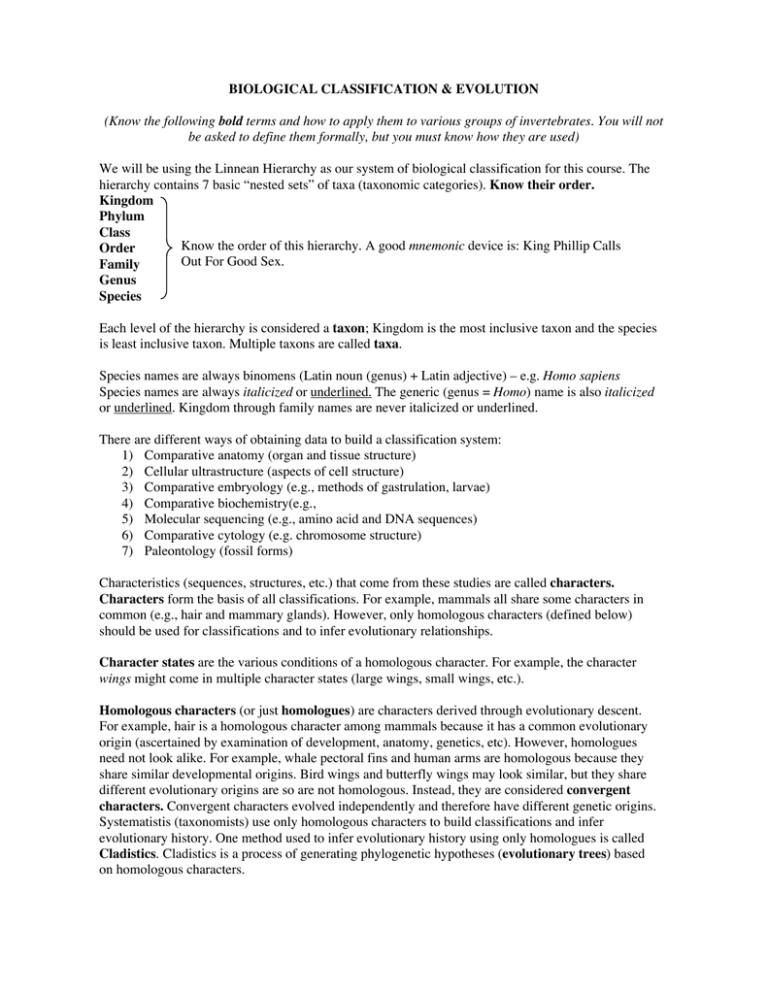
BIOLOGICAL CLASSIFICATION & EVOLUTION (Know the following bold terms and how to apply them to various groups of invertebrates. You will not be asked to define them formally, but you must know how they are used) We will be using the Linnean Hierarchy as our system of biological classification for this course. The hierarchy contains 7 basic “nested sets” of taxa (taxonomic categories). Know their order. Kingdom Phylum Class Know the order of this hierarchy. A good mnemonic device is: King Phillip Calls Order Out For Good Sex. Family Genus Species Each level of the hierarchy is considered a taxon; Kingdom is the most inclusive taxon and the species is least inclusive taxon. Multiple taxons are called taxa. Species names are always binomens (Latin noun (genus) + Latin adjective) – e.g. Homo sapiens Species names are always italicized or underlined. The generic (genus = Homo) name is also italicized or underlined. Kingdom through family names are never italicized or underlined. There are different ways of obtaining data to build a classification system: 1) Comparative anatomy (organ and tissue structure) 2) Cellular ultrastructure (aspects of cell structure) 3) Comparative embryology (e.g., methods of gastrulation, larvae) 4) Comparative biochemistry(e.g., 5) Molecular sequencing (e.g., amino acid and DNA sequences) 6) Comparative cytology (e.g. chromosome structure) 7) Paleontology (fossil forms) Characteristics (sequences, structures, etc.) that come from these studies are called characters. Characters form the basis of all classifications. For example, mammals all share some characters in common (e.g., hair and mammary glands). However, only homologous characters (defined below) should be used for classifications and to infer evolutionary relationships. Character states are the various conditions of a homologous character. For example, the character wings might come in multiple character states (large wings, small wings, etc.). Homologous characters (or just homologues) are characters derived through evolutionary descent. For example, hair is a homologous character among mammals because it has a common evolutionary origin (ascertained by examination of development, anatomy, genetics, etc). However, homologues need not look alike. For example, whale pectoral fins and human arms are homologous because they share similar developmental origins. Bird wings and butterfly wings may look similar, but they share different evolutionary origins are so are not homologous. Instead, they are considered convergent characters. Convergent characters evolved independently and therefore have different genetic origins. Systematistis (taxonomists) use only homologous characters to build classifications and infer evolutionary history. One method used to infer evolutionary history using only homologues is called Cladistics. Cladistics is a process of generating phylogenetic hypotheses (evolutionary trees) based on homologous characters. Some Cladistic Terminology Synapomorphy = shared derived character. A homologous character that is shared between 2 or more species (or taxa) (e.g., hair and mammary glands are synapomorphies of mammals). Sympleisomorphy = shared primitive character. A homologous character that is present in a taxon but does not necessarily define the group (e.g., four legs are present in all mammals, but do not define mammals only. Instead, four legs define all tetrapods, and so evolved prior to the appearance of mammals). Four legs is therefore a symplesiomorphy within mammals. chordates vertebrates tetrapods mammals Bass Primitive chordate lizard horse UML students D E B C A A. B. C. D. E. Vertebrae Four Legs Amniotic egg Hair Mammary glands The evolutionary tree presented above is a simplified example of a cladogram generated using cladistic methods. A cladogram is made up of multiple clades. A clade represents a monophyletic (defined below) branch on a tree. Above there are four clades: chordates, vertebrates, tetrapods, and mammals. Each clade consists of the ancestor (the branch point defined by an arrow) and the terminal branches (e.g., horse and UML students). Note that a clade is defined by synapomorphies. By convention, synapomorphies are placed on the evolutionary tree just prior to the branch point. For example, there are 5 synapomorphies shown on this tree, represented by the letters A-E. A is a synapomorphy of Vertebrates; B & C are synapomorphies of the tetrapod clade; D & E are synapomorphies of the mammalian clade. Curiously, synapomorphies can also be symplesiomorphies. For example, A is a symplesiomorphy within the tetrapods because it is a shared primitive character that shows up earlier on the tree (also, B & C are symplesiomorphies within mammals). In other words, whether or not a character is a synapomorphy or a symplesiomorphy depends on the character and group you are talking about. Other terms we can apply to this cladogram define ancestor-descendant relationships. Monophyletic – a clade that includes the ancestor (branching point of the tree) and all of its descendants (e.g., tetrapods and mammals are monophyletic clades, each with well-defined synapomorphies). Only monophyletic clades have synapomorphies and should be used in biological classifications. Paraphyletic – a clade that includes an ancestor and only some of its descendants. For example, the red circle includes the ancestor to lizards and horses, but leaves out monkeys, which are descendants of the same lineage. Such a clade is considered “unnatural” and not used in classification. Consequently, there are no synapomorphies that just define lizards and horses. Polyphyletic – a clade that contains species arising from two or more immediate ancestors. For example, the blue circle contains species of bass and lizards, but neglects their immediate ancestors. The words ancestral or primitive refer to characters (or character states) that have been around a long time and yet are still retained within a taxon. By definition, symplesiomorphies are a form of ancestral or character. For example, four legs are primitive characters of horses – they evolved prior to horses, but of course horses still retain four legs. The words advanced or derived refer to characters (or character states) that are relatively new to a taxon. For example, within the vertebrates, mammary glands are derived characters that mark the origin of mammals
